Author: Chris Geiger - geiger@off-road.com
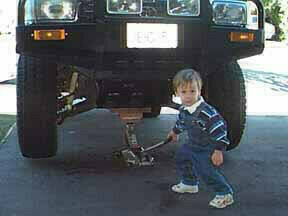
You can adjust the height of the front suspension by adjusting the torsion bars on IFS Toyota trucks (except Tacoma) '86-'95. These springs, as with all springs "sag" with time and use. Off-road driving accelerates this sag. Front torsion bars can be easily adjusted and the front suspension can be returned to the factory height or even lifted about 1.5"- by just turning a bolt!
If you drive off-road more than the average driver than you may want to consider using heavy duty torsion bars. These bars won't bend as easily and don't require readjusting after harsh driving. Heavy duty bars also give a slightly stiffer ride and prevent bottoming out of the suspension. The stock torsion bar is 22.8mm, heavy duty bars are available in 24mm and 26mm sizes. The 26mm size is the most common and is available from many offroad parts companies.
ADJUSTING TORSION BARS
 The torsion bar adjuster bolts are located under the truck near the frame rails about 10" back from the transfer-case cross member. Spray the bolt threads
with WD-40 or similar.
The torsion bar adjuster bolts are located under the truck near the frame rails about 10" back from the transfer-case cross member. Spray the bolt threads
with WD-40 or similar.
If you have a '86-'88 you may have a lock nut that must be removed before adjusting your bars. If your truck has this lock nut it may be difficult to remove. You may need to add a pipe on the end of your wrench to get this nut loose. This design was changed sometime in 1988 to the type shown below.
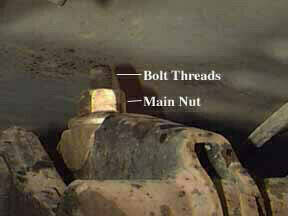 This is a picture of the adjuster bolt and nut from truck in the '88 - '95 range.
If you have this type, there is no locknut to remove.
This is a picture of the adjuster bolt and nut from truck in the '88 - '95 range.
If you have this type, there is no locknut to remove.
Now Tighten the 22mm bolt head a few turns (5 to 10 revolutions). Look at the upper nut when doing this, it should not turn, the bolt should turn inside without turning the nut. If the main nut turns with the adjusting bolt then you may already have a bad bolt bad in need of replacement. You should
replace the nut and bolt as a set for about $6 at any Toyota dealer.
You can put a wrench on the main nut while turning the bolt head but if it is hard to turn the bolt head it's time to replace the main nut and bolt. Do the same adjustment to the other side of the truck. Turning the bolt the same number of times. Here you can click to see what a new set of bolts looks like.
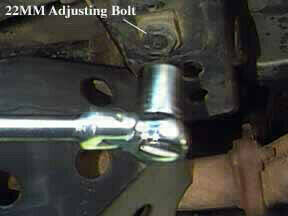
| Bolt | Nut | Lock-Nut | |
| 86-88 | 90101-12104 | 90170-12025 | 90170-12004 |
| 88-95 | 90101-12159 | 90179-12074 |
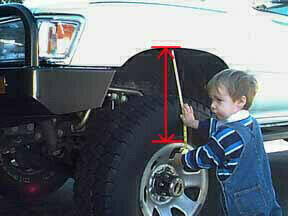 Drive down the street to set the bars in place. Measure the distance between the fender and the top of the rim on both sides (on level ground) and make
adjustments on one side or the other until they are the same height.
Drive down the street to set the bars in place. Measure the distance between the fender and the top of the rim on both sides (on level ground) and make
adjustments on one side or the other until they are the same height.
You should consider replacing the extension bump stops (the upper ones) to prevent the suspension from "topping out" and giving a harsh ride. There are 2 sizes available, low and ultra low. Replacing the upper bump stops (total of 2, 1 on the right and 1 on the left) will increase the travel available by allowing the tire to travel down farther than with the stock bump stops. Replacing the lower bump stops (total of 4, 2 on the right and 2 on the left) with low profile stops will increase the travel available by allowing the tire to travel up higher than before, however this may cause a bit of tire rubbing with larger than stock tire & wheel sizes.
With the use of low or (ultra low) profile bump stops available from Energy Suspension you can regain some ride comfort by allowing the upper arms to drop a little further. The higher you lift by adjusting the bars the greater the angle in the CV and tulip joints on the front axle shafts especially on trucks equipped with ADD. Trucks that came from the factory with manual hubs can reduce wear to the front drive shaft by unlocking the hubs when
not using 4WD.
AFTER ADJUSTING THE BARS
TRUCKS WITH ADD

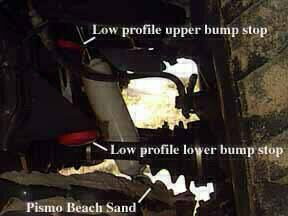

 Your Privacy Choices
Your Privacy Choices